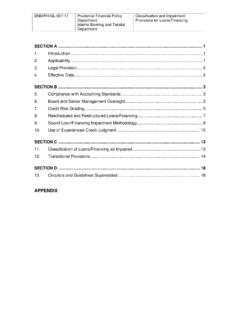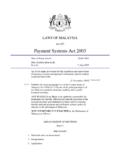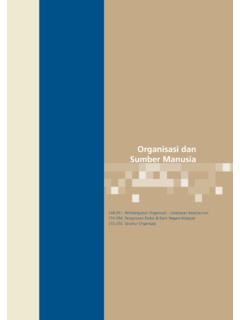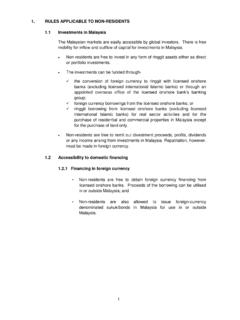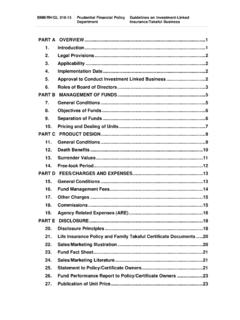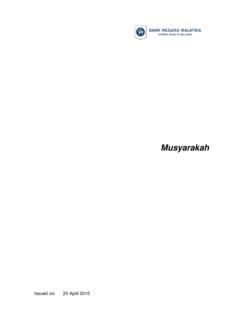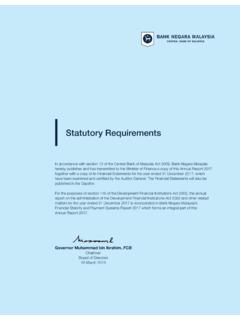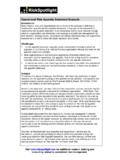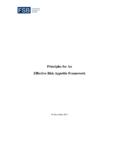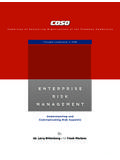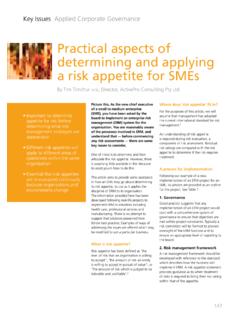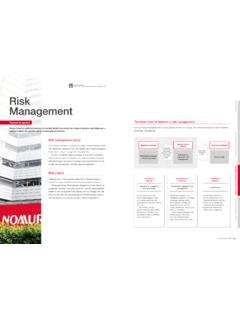Transcription of Operational Risk Management - Bank Negara …
1 Issued on: 27 June 2014 Operational Risk Management Concept Paper BNM/RH/CP 028-11 Prudential Financial Policy Department Operational Risk Management Page 2/23 Issued on: 27 June 2014 PART A Overview .. 3 1. Introduction .. 3 2. Policy objectives .. 3 3. Applicability .. 3 4. Legal provisions .. 4 5. Effective date .. 4 6. Interpretation .. 4 7. Related legal instruments and policy documents .. 5 PART B PRInciples for sound Operational risk Management .. 6 8. Board oversight .. 6 9. Role of senior Management .. 9 10. Sound internal control environment .. 13 11. Identification and assessment of Operational risks .. 15 12. Operational risk response and mitigation 17 13. Key Operational risk indicators and metrics .. 19 14. Operational risk reporting .. 20 Appendix 1 Example of Operational Risk Governance Model for Large Financial Institutions.
2 22 Appendix 2 Operational Risk Loss Event Type Classification .. 23 BNM/RH/CP 028-11 Prudential Financial Policy Department Operational Risk Management Page 3/23 Issued on: 27 June 2014 PART A OVERVIEW 1. Introduction Operational risk refers to the risk of loss resulting from inadequate or failed internal processes, people and systems; or from external events. Operational risk is inherent in all activities, products and services of financial institutions and can transverse multiple activities and business lines within the financial institutions. It includes a wide spectrum of heterogeneous risks such as fraud, physical damage, business disruption, transaction failures, legal and regulatory breaches1 as well as employee health and safety hazards. Operational risk may result in direct financial losses as well as indirect financial losses ( loss of business and market share) due to reputational damage.
3 2. Policy objectives This policy document: a. sets out the Bank s supervisory expectations with regard to the financial institution s Operational risk Management framework and practices; and b. forms the basis for the Bank s supervisory assessments of the effectiveness of an individual financial institution s Management of Operational risks . 3. Applicability The policy document is applicable to all financial institutions as defined in paragraph Notwithstanding paragraph : a. paragraph is only applicable to an active financial market player as defined in paragraph ; b. paragraphs and are only applicable to a large financial institution as defined in paragraph ; and 1 Including fiduciary breaches and Shariah non-compliance by Islamic financial institutions. BNM/RH/CP 028-11 Prudential Financial Policy Department Operational Risk Management Page 4/23 Issued on: 27 June 2014 c.
4 Paragraph is only applicable to a large financial institution or an active financial market player as defined in paragraph 4. Legal provisions The requirements of this policy document are specified pursuant to: a. sections 47(1), 56 and 266 of the Financial Services Act 2013 (FSA); b. sections 57(1), 65 and 277 of the Islamic Financial Services Act 2013 (IFSA); and c. section 41(1) of the Development Financial Institutions Act 2002 (DFIA). 5. Effective date This policy document comes into effect on DD MM 20XX. 6. Interpretation The terms and expressions used in this policy document shall have the same meanings assigned to them in the FSA, IFSA or DFIA, as the case may be, unless otherwise defined in this policy document. For purposes of this policy document: S denotes a standard, requirement or specification that must be complied with.
5 Failure to comply may result in one or more enforcement actions; G denotes guidance which may consist of such information, advice or recommendation intended to promote common understanding and sound industry practices which are encouraged to be adopted; financial institution refers to: a. a licensed bank, licensed investment bank, and licensed insurer under the FSA; BNM/RH/CP 028-11 Prudential Financial Policy Department Operational Risk Management Page 5/23 Issued on: 27 June 2014 b. a licensed Islamic bank, licensed international Islamic bank and licensed takaful operator under the IFSA; and c. a prescribed institution under the DFIA; active financial market player refers to a financial institution that is a major or key participant, or an infrastructure/service provider (such as clearing, payment, settlement and custodial agents) in the capital, money, foreign exchange and derivative markets.
6 Large financial institution refers to: a. a financial institution with multiple sizeable businesses within the entity; b. a financial institution with a large network of offices within or outside the country; or c. a financial conglomerate with multiple sizeable entities within the corporate group. 7. Related legal instruments and policy documents This policy document must be read together with the following policy documents issued by the Bank: a. Policy Document on Risk Governance; b. Policy Document on Operational Risk Reporting Requirement Operational Risk Integrated Online Network (ORION); c. Guidelines on Introduction of New Products; d. Guidelines on Outsourcing; e. Guidelines on Management of IT Environment; and f. Guidelines on Business Continuity Management . BNM/RH/CP 028-11 Prudential Financial Policy Department Operational Risk Management Page 6/23 Issued on: 27 June 2014 PART B PRINCIPLES FOR SOUND Operational RISK Management 8.
7 Board oversight Principle 1: The Board must be aware of and understand all major Operational risks that could significantly impede the financial institution s ability to meet its obligations towards customers and counterparties, as well as those that could threaten the financial institution s safety and soundness. The Board must approve the financial institution s Operational risk appetite that sets out the tolerance towards the major Operational risks and the strategies for managing risks within the tolerance limits. The Board must be aware of and understand the nature and complexity of the major Operational risks in its business and operating environment, including risks arising from transactions or relationships with third parties, vendors and should include an understanding of both the financial and non-financial impact of Operational risk to which the financial institution is exposed such as the impact arising from legal liability, loss of recourse, restitution, write downs, business interruption and damage.
8 The Board must receive assurance that all key interdependencies between business and functional lines3 are identified and ensure that it has a good understanding of the inter-relationship between Operational risk and other financial and non-financial risks4. In particular, the Board must recognise and understand how Operational risks affect the Management of other financial and non-financial risks , and vice versa. The Board must review and approve the Operational risk appetite statement that covers all major Operational risks that the financial institution is exposed to. In doing so, the Board must consider the financial institution s level of risk aversion, its financial condition, its current and future business direction and the quality of its internal control environment. 2 Suppliers include outsourcing service providers.
9 Specific requirements on outsourcing Management are set out in the Guidelines on Outsourcing. 3 Such as Human Resource, Finance and Information Technology. 4 Including but not limited to credit, market, liquidity, Shariah and insurance risks . S S S BNM/RH/CP 028-11 Prudential Financial Policy Department Operational Risk Management Page 7/23 Issued on: 27 June 2014 The risk appetite statement must include risk limits and thresholds approved by the Board for specific Operational risks and an aggregate Operational risk limit reflecting the financial institution s tolerance towards Operational risks . The risk limits must be consistent with Management s strategies for managing risks within the limits and thresholds set. In respect of an active financial market player, the Board must ensure that the Operational risk appetite statement includes all major Operational risks associated with the financial market activities that the institution is involved in5.
10 The Operational risk limits and thresholds should reflect an appropriate combination of quantitative metrics as well as qualitative analysis of major Operational risk exposures, taking into account conditions in the financial institution s business and operating environment as well as factors that can increase Operational risk exposures but which may not be adequately captured by quantitative measures. The Board should also consider limitations in Operational risk measurement methodologies that are still evolving, and ensure that the Operational risk limits and thresholds set appropriately address these limitations in order to effectively manage and contain exposures to Operational risk. Principle 2: The Board must oversee the design and implementation of a sound Operational risk Management framework and provide constructive challenge to senior Management on the credibility and robustness of the policies, processes and systems for managing major Operational risks .
